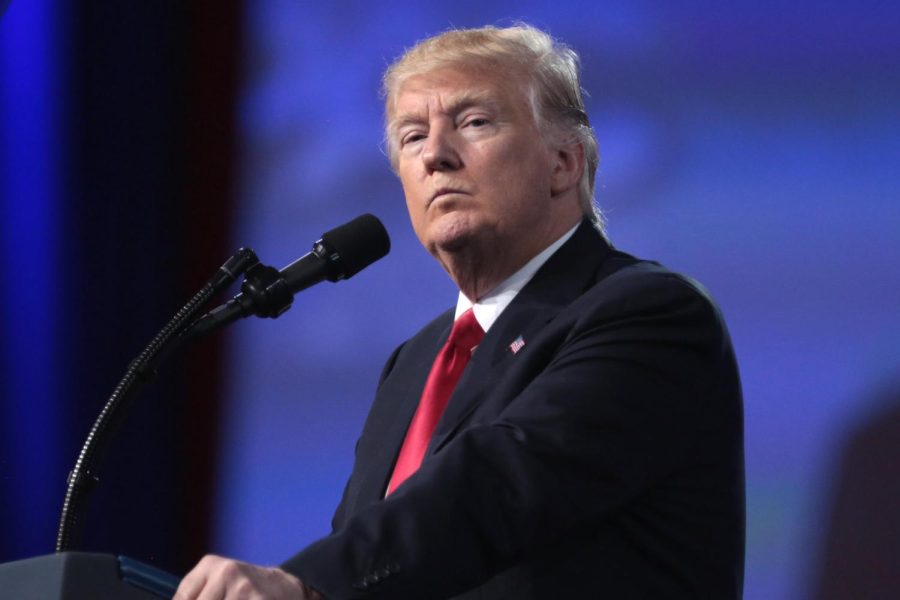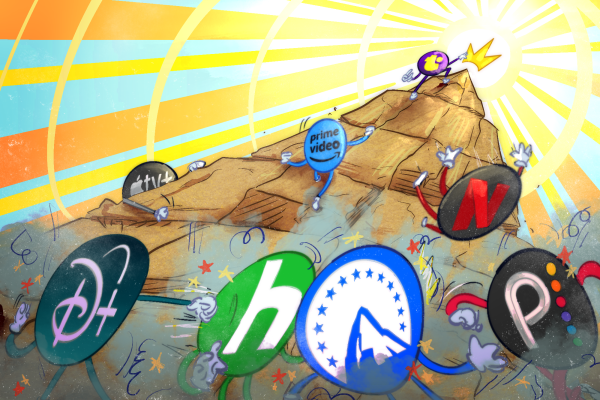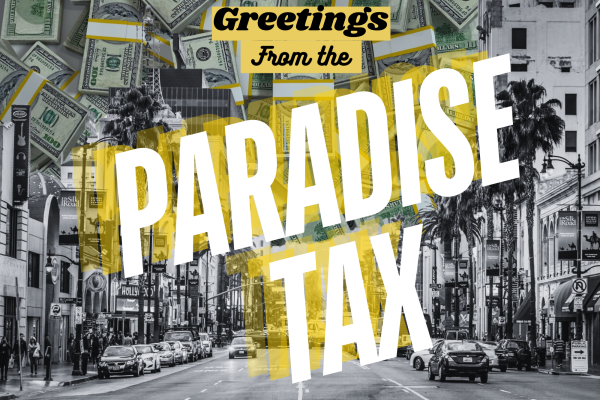Column: The hubris of a pariah
Trump’s spiral is reminiscent of two other notable gadflies
An administration tarnished by wrongdoing and misconduct, a lousy response to social unrest and a pandemic, two impeachments and several criminal inquiries resulted in this surreal statement.
“I’m doing my first official Donald J. Trump NFT collection right here and right now,” the former president said in an announcement yesterday.
The unreality of Trump referring to himself as “better than Lincoln, better than Washington” could only be topped by the unveiling of his NFT collection whose art invokes a dumbfounded laugh at best and a sense of uncanny valley at worst.
Trump’s newest grift is, by all measures, absurd – the overblown announcement, the ridiculous execution and the very fact that he has stooped to selling the same snake oil used by deceitful influencers and bought-out C-tier celebrities. But the introduction of his “Trump Digital Cards” is only the latest stumble in his spiral toward social destitution. The few scraps of good repute he had in the conservative sphere post-presidency shrank significantly after the midterms and continue to crumble.
The collapse of the Trump empire – knock on wood – begs the question, “How did he get here?”
Ask Icarus. Or, for more contemporary examples, Ye, formerly known as Kanye West, and Elon Musk.
Although Musk is still in the process of singeing his wings – to continue the Icarus analogy – Ye has plunged into the ocean and completed his metaphorical flight too close to the sun. The three men are not carbon copies but they share similar selling points that ultimately resulted in their downfalls: populism and ego.
For Ye, the anti-establishment messaging lies within his music, like his debut album “The College Dropout” and its rebuke of the higher education system or his song “New Slaves” and its reproach of corporations. Ye’s career is also rife with boat-rocking moments like saying “George Bush doesn’t care about Black people” on live TV during a fundraising event for Hurricane Katrina victims or interrupting Taylor Swift’s acceptance speech at the 2009 MTV Video Music Awards which, for right or wrong, has made him more popular.
Over time, Ye shifted gears and started appealing to a conservative audience. He wore a “Make America Great Again” hat, met with Trump, and recently, donned a “White Lives Matter” shirt alongside Candice Owens at a fashion show.
In Musk and Trump’s case, they built their populist brand by selling themselves as “outsiders” however they did so through different means.
“All language use contributes to a persona. … and Trump’s persona is, arguably, carefully crafted as the antithesis of the conventional politician,” wrote Dr. Susan Hunston, professor of English at the University of Birmingham. “In other words, Trump’s language appears to be designed to align him with non-politicians, to assert his identity as a ‘common man.’”
The ill-fitting suits, less-than-professional conduct and lexicon were implicit tools to appeal to a base. Trump never sought to win over liberals but to craft an image that conservatives could look at and think that as a reflection of themselves.
In a similar vein, Musk appealed to the “common man” by attempting to appear funny and relatable, smoking marijuana with Joe Rogan, appearing in popular YouTuber PewDiePie’s video and hosting an episode of “Saturday Night Live.” These acts and his never-ending flow of tweets are all a concentrated effort to create a “cool” billionaire image. This campaign has been palpably effective: those who criticize Musk on Twitter are inevitably greeted by a gang of his omnipresent acolytes.
And so, at one point or another, all three were able to use populism as a tool to create a following that allowed them to become influential, and to different degrees, powerful. But what’s created can also be destroyed, the same hubris that enabled these men to ascend ultimately led to their descent.
Beginning in early October, Ye went on a multimedia tirade regurgitating antisemetic conspiracy theories about Jewish people’s “influence” on the world and made insinuations about money. He used Instagram and Twitter to amplify the rhetoric and went on a media tour of interviews and podcasts to do the same.
“I can say antisemitic things and Adidas can’t drop me,” Ye said on the podcast Drink Champs on Oct. 16. “Now what? Now what?” he repeated with a smirk.
Eight days prior, he tweeted, “I’m going death con 3 on JEWISH PEOPLE.”
On Oct. 25, Adidas dropped him, joining a myriad of other companies to do so, dropping his net worth by hundreds of millions. The penalizing didn’t stop him: in late November, Ye took Nick Fuentes, a notorious white nationalist, to have dinner with Trump at Mar-a-Lago, to which the former president received backlash from both the left and the right and had to distance himself from the two men.
Ye’s antisemetic tour culminated in an appearance on Alex Jones’ Infowars where he said, “I like Hitler,” among other comments that made even Jones squirm uncomfortably.
Though a worryingly considerable portion of his fanbase still backs Ye, he has irreversibly obliterated his reputation in the mainstream, lost his influence in the fashion world and isolated himself to the company of other outcasted far-right figureheads like Fuentes. He has lost almost everything for the sake of a racist conspiracy theory.
Although Musk retains popularity with his base, his time as Twitter’s owner has resulted in nothing but left and right hooks to his wallet and ego. Since his takeover as owner, half of the website’s top 100 advertisers have ceased operations on Twitter, according to NPR. Insider Intelligence forecasted that the website – because of the downsized staff and Musk’s antics – will lose over 32 million users by 2024.
Yesterday, the self-proclaimed free speech absolutist banned several high-profile journalists who had been covering him, claiming that they had doxxed him when in reality the information being shared was perfectly public. He then ran a poll to decide when the journalists should be unbanned, and when a majority voted to unban them immediately, he made an excuse and disregarded the poll results, contradicting the absolutism he swore to.
European Commission Vice President Vera Jourova tweeted that the bans are in violation of the European Union’s Digital Services Act and Media Freedom Act and threatened sanctions against Twitter.
The chaos is also spilling into Tesla, which has lost $705 billion in market capitalization since Musk revealed his stake in Twitter back in April of this year, according to Forbes.
Musk’s Twitter woes are entirely self-inflicted; his hubris led him to believe that he could slash the company’s staff by more than half, gut its infrastructure and elevate GOP talking points without repercussions. The fact is, in the span of a few years, Musk went from generally liked to utterly disdained by the demographic most likely to buy his cars and use his website.
Back to the man of the hour, Trump, whose rise and fall eclipses the other two in scale and incompetence. From the most powerful man in the world to promoting NFTs.
What went wrong? Everything, frankly. But what really was the beginning of the end for Trump was the events of 2020. The pandemic and the social unrest following George Floyd’s murder were the catalysts for Trump’s spiral into where he’s at now. The two situations were completely mishandled – COVID-19 became a centerpiece for the culture wars and the protests were met with heavy police pushback – which galvanized people to cast a ballot.
The next domino to fall was Trump’s refusal to accept the election results. The lawsuits, the recounts, the baseless lies all amounted to nothing – most Republicans accepted the November midterm results because they realized that the fraud claims were baseless. But in that era, disbelief in the results was significant which Trump used for one last Hail Mary – the riot at the Capitol.
This was a flashpoint in this series of events: moderates, independents and key GOP officials severed ties with Trump here. Critical support that he needed to remain influential in the Republican Party began to wither.
The final blow was the outcome of the midterms. In races that mattered, the majority of Trump-backed candidates lost. The pattern had become clear: Trump lost the popular vote in the 2016 and 2020 presidential elections and the 2018 and 2022 midterms. He is an unviable candidate. Through his actions, his reckless grasps at power, he lost support from independents, moderate Republicans and his own colleagues.
It’s not looking great for the former president. Gov. Ron DeSantis is looking like a stronger candidate by the day, meanwhile Trump’s lack of voice in D.C. and on social media is hindering his chances.
For the record, this doesn’t mean he’s through. Politics are unpredictable. Democrats were able to pull off a seemingly impossible win just last month, it is entirely possible for Trump to do the same in two years. If DeSantis – who is notorious for having a weak stage presence – does run a campaign, there’s a real possibility that Trump bullies him the way he did Jeb Bush and becomes the favorite again. If this were to occur, not only would the Republican Party fall back in line, Democrats would need to prepare for the return of a president who not only damaged the pillars of democracy but is coming back to finish the job.













